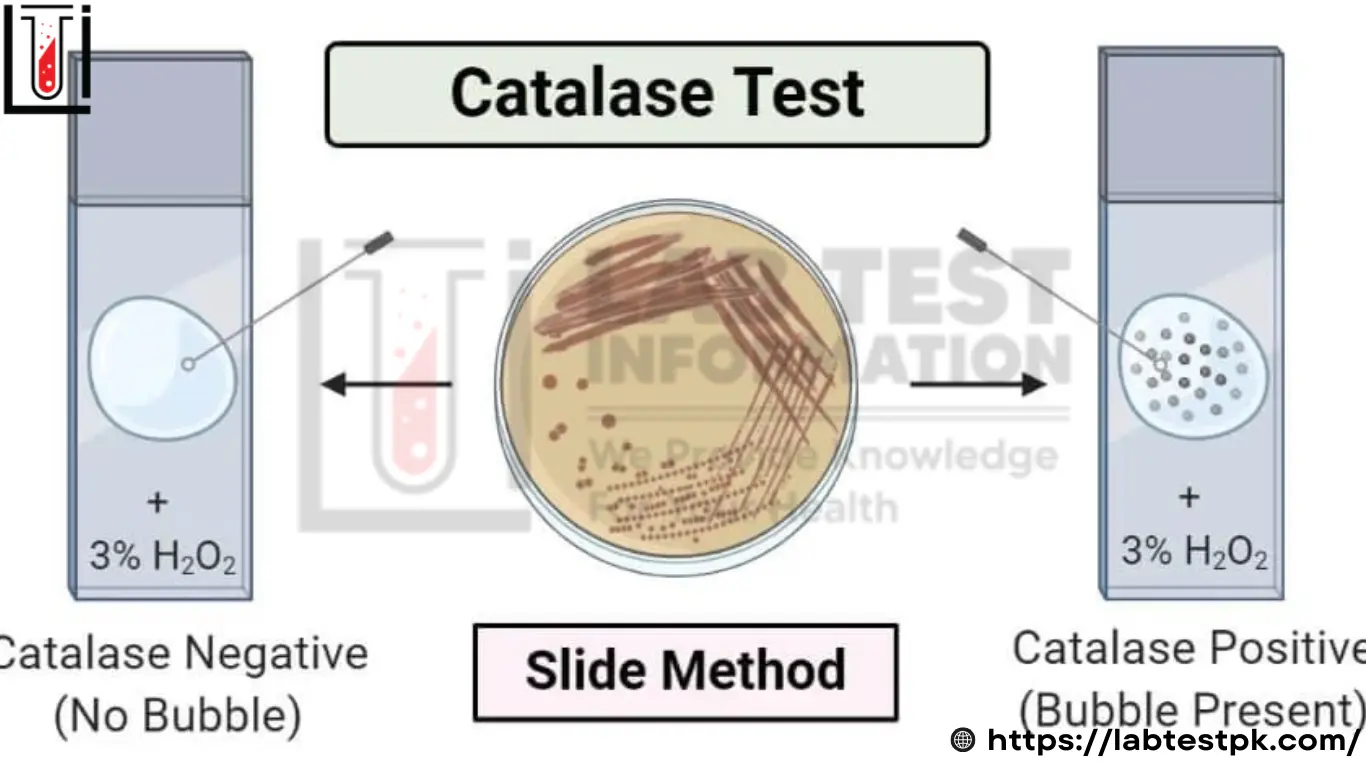Catalase Test
Catalase Test is a biochemical test. This test is used to differentiate these bacteria that produce the enzyme catalase, such as staphylococci from non-catalase Producing bacteria such as streptococci.
Also valuable in differentiating aerobic and obligate anaerobic bacteria. It is also used to differentiate clostridium, which is catalase negative, from bacillus species which are catalase Positive.
Catalase test can be used in the identification of Enterobacteriaceae.
Principle:
Catalase mediates the breakdown of hydrogen Peroxide (H2O2) into oxygen and writer. To find out if a particular bacterial isolate can produce catalase enzyme, a small inoculum of a bacterial is late mixed into a 3% H2O2 solution. It is observed for the rapid elaboration of oxygen bubbles. The lack of catalase is evident by a lack of double production.
Catalase:
| Also known Production | Catalase is an enzyme. It is produced by all living Plants, animals, and some species of bacteria. |
| Presence | Which are always exposed to 02– catalase Enzyme also present in aerobic and facultative anaerobic micro-organisms. |
| Catalase Produce through | Bacteria can only make catalase if they have the gene for catalase in their DNA. |
Types of Catalase:
1-Aerobic Metabolism:
Bacteria that conduct aerobic metabolism (biological reaction) require Or Produce H2O2 as a toxic Product of their metabolism.
Cause:
Toxic H₂O2 can cause intracellular damage such as damage to DNA, Lipid, and proteins. To remove H2O2 and other similar compounds, cells Produce catalase enzyme to break down H2O2 into liquid water (H2O) and oxygen (Or) 2H2O2 Catalase 2H2O + O₂.
2- Anaerobic Metabolism:
Anaerobic micro-organisms do not survive in the Presence of oxygen as H2O2 is produced and due to lack of catalase enzyme this H2O2 destroys the cell enzyme system and the cell dies.
How to Perform Catalase Test in Lab:
There are two methods of the Catalase test:
- Test tube Method:
- Slide Method:
1- Test Tube Method:
In the test tube method, the catalase test is Performed in a sterile test tube:
Requirements:
- Bacterial culture
- Sterile Test tube
- Dropper
- Wire Loop
- 3% H2O2 (Hydrogen Peroxide)
Tube method:
- 3./. H2O2
- Catalase Negative
- no (bubble)

- 3% H2O2
- Catalase Positive
- (Bubble Present)
Procedure:
- Add 1-2 ml of H2O2 solution into a test tube.
- Further, with the help of a sterile niche wine loop, a colony of a test culture is Picked 2 up and inserted in H2O2 containing test tube.
- Observe for immediate bubbles.
Slide Test Method:
In a slide Method, the catalase test is performed in a clean grease free slide:
Requirements:
- Bacterial culture.
- Clean Grease-free slide.
- Wire Loop, sterile wooden stick.
- 3% H2O2 (Hydrogen peroxide).
Procedure:
- Use a nichrome wire loop to transfer a small amount of colony growth to the surface of a glass slide.
- Place a 2-3 drop of 3% H2O2 in the glass slide.
- After the addition of H2O2, the slide is observed for the formation of oxygen bubbles.
Precautions:
- The test organisms should not be taken from blood agar culture 2 red blood cell contains catalase.
- Culture should be 18-24 hours old Iron wide loop should not be used.
Result Interpretation:
| Catalase Positive Bacteria | Catalase Negative Barteria |
| Staphylococci, Micrococci Listeria, Corynebacterium diphtheriae, Burkholderia cepacia, No cardia, the family Enterobacteriaceae (Citrobacter, E.coli, Enterobacter, Klebsiella, Shigella, Yersinia, Proteus, Salmonella, Servatia is endomonas, mycobacterium, tuberculosis, Aspergillus, Cryptococcus and Rhodococcus equi. |
No- Bubbling Examples: Streptococcus and Enterococcus spp |
NOTE:
Care must be taken when testing an organism cultured on a medium containing blood because catalase is Present in red cells.
Caution:
Performing the test on the slide is not recommended because of the risk of contamination from active bubbling. When the rapid slide technique is used, the hydrogen peroxide solution should be added to the organism. Suspension after placing the slide in a Petri dish. The dish should be covered immediately, and the preparation observed for bubbling through the lid.


[…] cells (UTI), Leucocytes, Epithelial cells, Nitrates, Phosphates, Filariasis, […]
Статья дает понимание о том, какие данные и личную информацию следует оставлять при размещении объявлений на досках.
I have been browsing online greater than three hours today, but I by no means found any fascinating article like yours. It is beautiful price enough for me. Personally, if all webmasters and bloggers made excellent content as you did, the net might be much more useful than ever before.
NEVER quit trying. Goals!
Have you ever considered creating an ebook or guest authoring on other websites? I have a blog centered on the same topics you discuss and would really like to have you share some stories/information. I know my readers would appreciate your work. If you are even remotely interested, feel free to send me an e mail.
I like this-Helpful to find, but I am not sure where to start. Which of your posts can you recommend I read next?
[…] blood tests […]
[…] at least 2 ml of arterial blood in a heparinized syringe or Gareen Top tube with Sodium heparin or Lithium Heparin from Radial artery or Brachial Artery or Femoral […]
[…] Stone Analysis […]